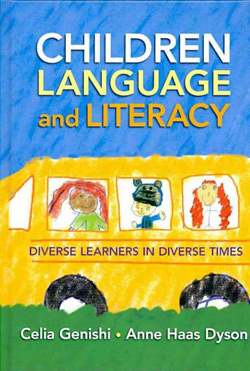Filed Under > Research/Publications
When Kindergarten Is No Longer Child's Play
In their new book, TC Professor Celia Genishi and colleague Anne Haas Dyson decry the increasing "homogenization and regimentation" of the early childhood classroom.
In a new book, Children, Language and Literacy: Diverse Learners in Diverse Times, (Teachers College Press, 2009), Genishi, Professor of Education at TC, and her long-time collaborator Anne Haas Dyson of the University of Illinois, decry what they describe as the drift in recent years toward an increasingly academic prekindergarten through primary-grade experience.
Genishi and Dyson lament the “homogenization and regimentation” of the early childhood classroom--the disappearance of playtime, read-alouds and naps and the emergence of a structured curriculum replete with reading and writing programs, literacy instruction and even standardized tests in the early grades--at a time when the public schools are becoming ever more diverse racially, ethnically and linguistically
“It’s a very narrow conception of early education,” says Genishi, who chairs TC’s Department of Curriculum and Teaching. “It’s focused on the learning of skills, and especially in kindergarten through grade two, it’s so much about learning to read. It’s not that we don’t want kids to read. Of course, we want everyone to read, but I think there is this growing anxiety--to the point of obsession--over the idea that children have to read as early as possible. The current climate makes parents very anxious and the economy isn’t helping. There is a sense that, ‘Oh, my. My child doesn’t read at the age of three, she won’t go to Harvard.’”
Children, Language and Literacy is not a policy screed but instead an effort to capture some of the ways children learn to become flexible communicators, as well as readers and writers. The book is filled with vignettes of youngsters, most of whom are children of color in urban schools, learning to become social beings and students in ways that are effective, but that seem to defy standardization. To Genishi and Dyson, that’s the point: Young children should be treated as individual learners who need the time and space to explore language, to play and to learn. Imposing a hard-and-fast curriculum for any group of children is counterproductive, with poor children at particular risk of being “cast as deficient problems-to-be-fixed, especially in the areas of language and literacy.”
Children, Language and Literacy is Genishi and Dyson’s fourth book together. The duo first collaborated on Language and Assessment in the Early Years, which was published in 1984. In fact, it was in the 1980s, Genishi says, that the movement toward more explicit academic instruction in the early grades first began to take root. By the late 1980s, early education advocates and scholars were raising concerns about “hot housing,” or making preschool and kindergarten classrooms increasingly like the primary grades. The No Child Left Behind Act, passed in 2002, accelerated the push toward high-stakes testing and a more structured curriculum in the early grades.
Such is the state of affairs that a few years ago in New York City, Genishi says, some public schools barred teachers from purchasing building blocks for their kindergartners lest they spend too much time on play. In the book, Genishi and Dyson make the case that play is not a diversion, but instead serves as an important path on which children learn in those early years of schooling.
“We advocate for a broader, more humane curriculum where there are more choices for children to be involved in activities, activities that the children choose spontaneously,” Genishi says. “They can choose to be at the art table, or pick up a book instead of taking part in a directed lesson on reading, or go over to the dramatic play corner—if the classroom still has one. The tradition in early childhood education has been to have those centers and give children choices and the time to experience those activities and those are the things that are dropping out as the focus on academics increases.”
Given the diverse nature of how children learn and the diversity of languages and cultures in the schools, Genishi and Dyson call for changes, including easing the pressure of inflexible, mandated curricula by providing children “unhurried time” for learning. (“This is the opposite of the timed test,” Genishi says.) They also advocate for teachers to have access to adequate professional development courses on the latest in language development so they can gain greater perspective on diversity as a strength that can enrich the language experiences of all students rather than a detriment to be overcome.
Genishi and Dyson hope the book becomes part of the growing chorus of criticism of a rigid and narrow early education curriculum, and that it will find its way into graduate school classrooms and into the hands of teachers. The book is expected to gain a wide readership among educators because it’s co-published by the National Association for the Education of Young Children, which will provide 25,000 of its members with a copy.
In the end, Genishi and Dyson are realistic. The era of accountability is here to stay, at least for the foreseeable future. Still, their experiences in classrooms around the country have taught them that no matter how scripted the curriculum, young children have an uncanny way of finding time to play, learn and grow on their own schedule.
“Even though the teacher has the script, the children don’t,” Dyson says. “And that’s always the fun of it, the challenge of teaching. We’ve tried to provide information that we believe can help teachers understand language diversity both in terms of multilingualism and the speaking of the many ‘Englishes’ that children speak. So as part of our story, we provide that information because whatever the script or curriculum is, the kids don’t have it. So if you’re going to be a teacher, you’re going to have to go off script because the kids will.”
Published Tuesday, Jul. 7, 2009
